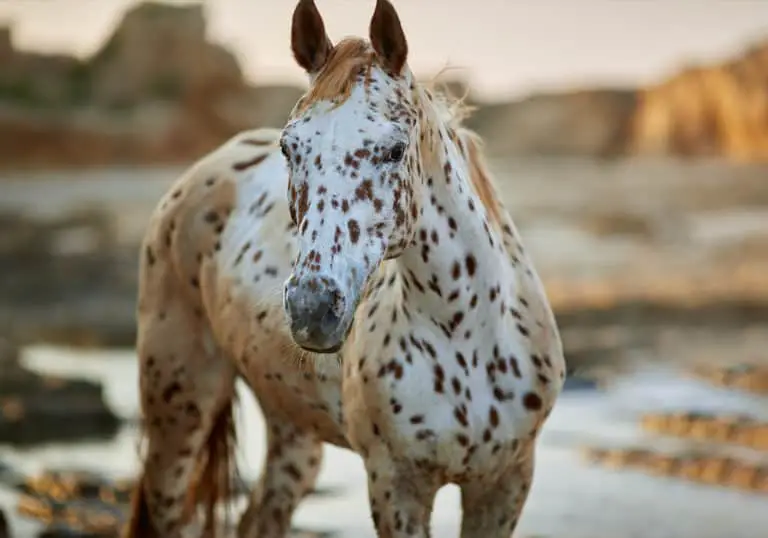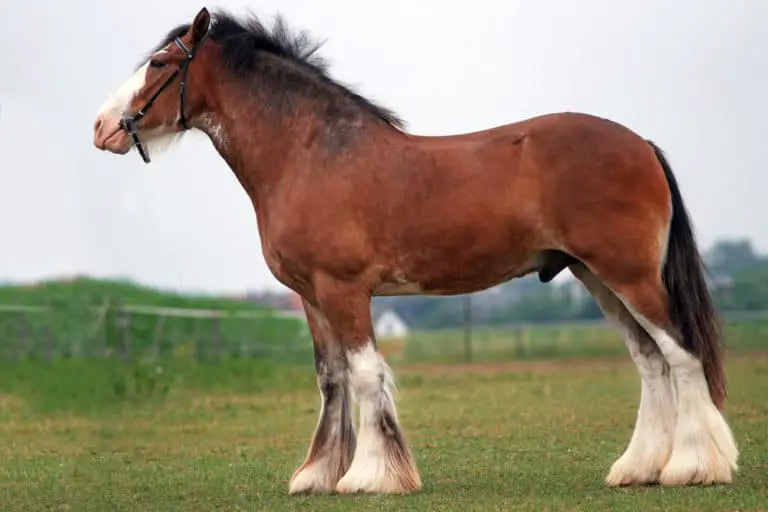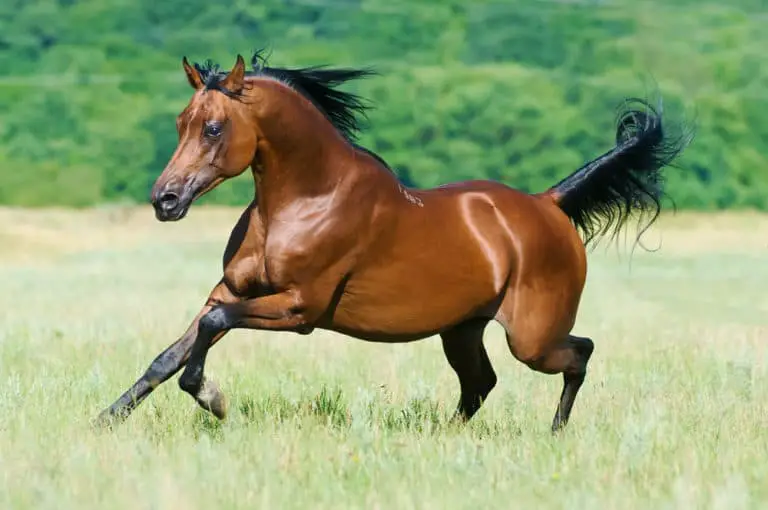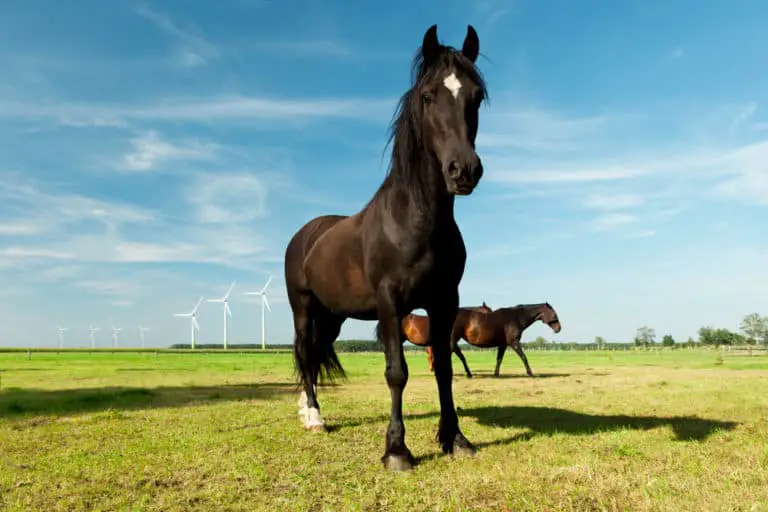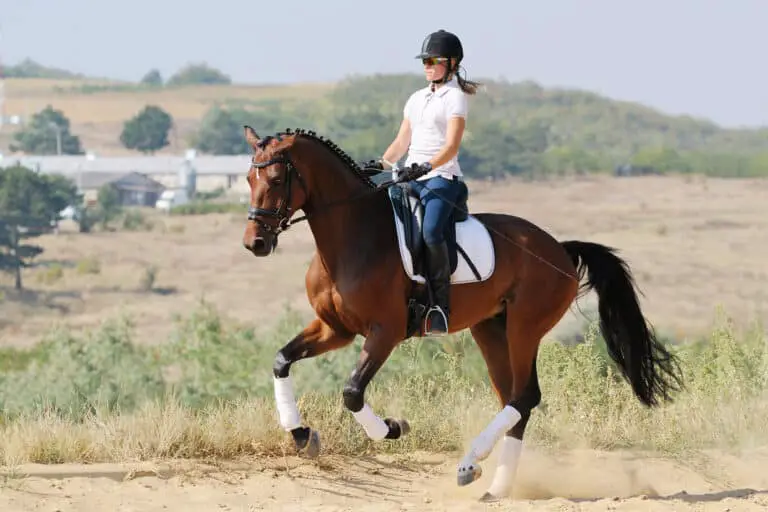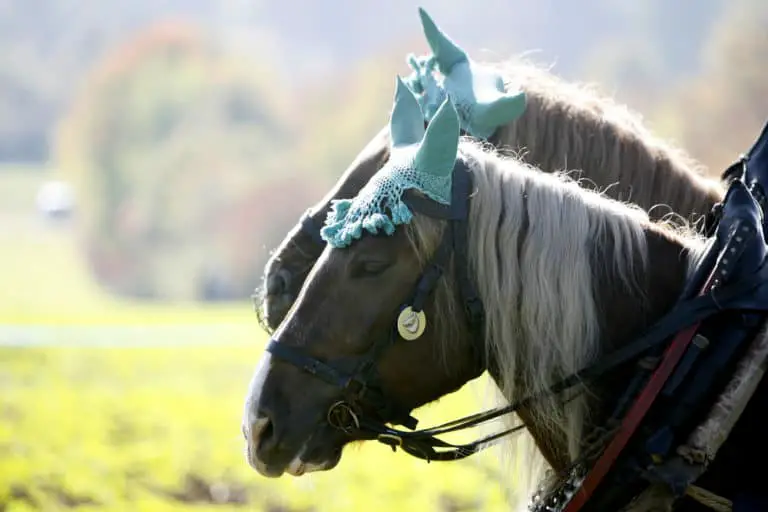Dutch Warmblood Breed: Care, Cost & History (2025)
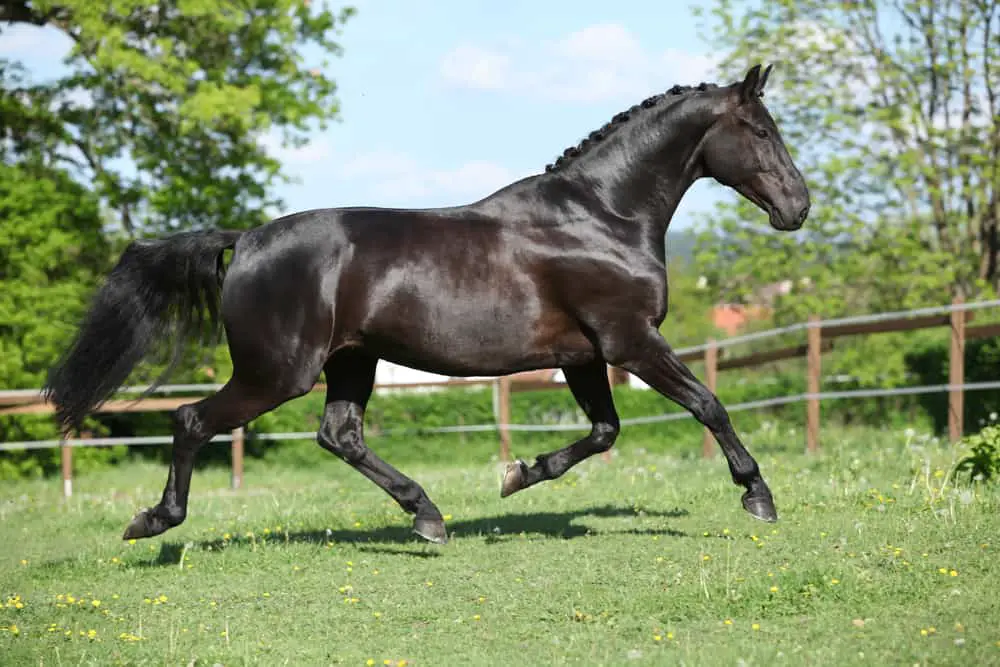
The Dutch Warmblood horse is one of the Netherlands’ most prestigious horse breeds. The elegant and competitive Sports Horse is famous as one of the most distinguished equine breeds registered by the Royal Warmblood Studbook of the Netherlands (KWPN).
They are specifically bred for show jumping, dressage, and the accomplishments of this breed have made them the epitome of equine excellence in Postwar Europe.
Breed: Dutch Warmblood Horse
Adult Weight: 1,433 lbs or 650 kg
Adult Height: 16.2 –17 hands (64–68 inches)
Origin: Netherlands
Use: Show Jumping, Dressage, in Harness, Hunting
Colors: Black, bay, chestnut, brown, gray
Features: sporty, elegant, well-muscled
Lifespan: up to 30 years
Character: strong-willed, friendly, intelligent
Gait: light-footed, tactful
Best for: Professionals and competitive riders
- Characteristics
- Dutch Warmblood Care
- Dutch Warmblood History
- Modern Dutch Warmbloods
- Cost and Ownership
- Buying a Dutch Warmblood
- Similar Breeds
Dutch Warmblood Horse Characteristics
Dutch Warmblood horse characteristics are distinguished by the horses being suitable for Grand Prix Level riding. Dutch Warmblood horses must show the will to perform and are friendly towards their rider according to the official KWPN breeding goals. The KWPN Breeding Association of North America strictly regulates how a Dutch Warmblood Horse should look and perform.
The Dutch Warmblood must have a functional conformation and a correct movement mechanism that enables good performance (1). The Dutch Warmblood horse head must be in harmony with the horses’ overall attractive conformation along with refinement, nobility, and quality.
Size
There is no official breeding standard for the Dutch Warmblood size of the kwpn horse. Neither is there any regulation for the Keuring of a Dutch Warmblood (2). Even though, their height is acknowledged to be between 16.2 –17 hands (64–68 inches) for adult horses (4).
Of course, horses vary in size and can be taller or smaller, but if a horse is too small, they can not compete in dressage or show jumping and would therefore not be acknowledged by the breeding society.
The Dutch Warmblood horse height makes this horse suitable for riders of all heights, which is convenient for many riders participating in dressage and jumping competitions.
Weight
The Dutch Warmblood horse weight is not regulated by the breeding societies, but as a sports horse and a warmblood, their weight is similar to that of comparable breeds like an Oldenburger horse and will be around 1,433 lbs or 650 kg.
The breeding society designates the kwpn breed to be long-lined with muscular with a muscled topline and a well-muscled loin formation (2).
Comparing them with other light horse breeds, their weight can be categorized as heavy due to their rather tall height and the weight of their muscles.
Still, the KWPN Horse would not be considered a heavy horse like for example a Draft horse like a Clydesdale. They are considerably lighter than draft horses that can weigh up to 2,000 lbs (3).
Colors
The Dutch Warmblood is a specific breed and has a breeding society, but still, their studbook is not closed which allows many other breeds to be introduced to their gene pool (4).
The studbook of the Dutch Warmblood is more regulated by behavior, abilities, and confirmation rather than physical features like Dutch Warmblood colors. This is why the beautiful Dutch Warmblood horse can appear in almost any color theoretically.
Most KWPN horses have solid coat colors like brown, black, chestnut, bay, and gray. But there are rare Dutch Warmblood colors like palomino, cremello, and champagne. Patterns are allowed and can be spotted commonly.
Temperament
Dutch Warmblood horse temperament is one of their best traits since they have courage, are willing, hardworking, intelligent, and easy to handle (2).
Dutch Warmblood behavior is a perfect composition of quick reactions, willingness to perform and learn, and social kindness.
They have the ability to perform at the highest levels like the Grand Prix with many people watching and cheering them without spooking or getting frightened.
Dutch Warmblood horse training has been perfectionized by the breeding societies since 2006 where they specifically breed different temperament horses for specific disciplines. The KWPN does this to achieve more accomplished horses with every single sire.
Dutch Warmblood Horse Care
The Dutch Warmblood horse lifespan can be up to 30 years which is a great age for a horse. To achieve this wonderful life expectancy for a horse of the Dutch Warmblood breed, you must care for it frequently and extensively without any exceptions or excuses.
There is a lot of care and time involved when it comes to caring for horses. Any rider must create a habit of grooming and caring for their horses. Competitive riders should accelerate the care even further since sports horses need more care than simple riding horses that are used for pleasure only.
Diet and Nutrition
The Dutch Warmblood diet is susceptible to their use. Performance horses usually need more supplements and grain to be able to burn all that needed energy they need to participate in competitions and the training beforehand. Still, they do not eat considerably more than the average sports horse and even less than a cold blood (5).
The Dutch Warmblood needs a diet to meet that of warmblood breeds which mainly consist of a variety of forage and fresh hay. You should add some high-quality grain feed, fruit, and vegetables as well to offer your horse a variety of nutrients. (5)
Regardless of how you use your KWPN horse, it must be fed accordingly to the warm-blood diet. Even if you don’t use your Dutch Warmblood for dressage or show jumping, you should adhere to their recommended diet.
Health Problems
Dutch Warmbloods are healthy horses with a low incidence of genetic problems. This is astonishing since they are one of the most inbreed breeds with low genetic variation. The reason for their great health is the strict breeding regulations regarding genetic problems
and health issues occurring in potential candidates for the registry.
The breeding association in the Netherlands won’t accept an ill or compromised Dutch Warmblood stallion or horses with genetic diseases to adhere to their strict breeding goals. The Dutch breeders want to make sure that no health problems or genetic diseases can be passed along among the registered horses in their breeding association.
One genetic disease which is known to occur frequently in warmbloods is the Fragile Foal Syndrome (WFFS) which results in the birth of non-viable or stillborn foals with abnormally fragile skin (6).
Grooming
Dutch Warmblood grooming is not different from grooming other sports horses in general and, therefore, will be pretty time-demanding. Owning a horse will take up most of your free time.
Luckily the Dutch Warmblood horse breed has no feathers, but their regular exercise makes grooming intervals shorter. You need to wash your horse if it is sweating regularly or heavily after every 2-3 training sessions. Otherwise, you and your horse might have to deal with skin infections and irritation (7).
Brush the coat of your horse every day with a body brush to clean it from small particles and strengthen your relationship (7). Use a Curry Comb to remove more serious dirt and grease from the coat and to stimulate the blood flow (7).
Dutch Warmblood Horse History
The Dutch Warmblood horse history was mainly documented by the KWPN breeding association of the Netherlands and shows a rich history. In the beginning, the KWPN horse was valued for its pulling power only and used as a farm horse. Nowadays the Dutch Warmblood arose into one of the most successful competitive breeds worldwide.
The original Dutch farm workhorse was the starting point for four different breeding directions that emerged later in the Netherlands. The original Gelder type remains closest to the original foundation horse.
Origin
The Dutch Warmblood horse origin lies in the Netherlands as the breeds name already indicates. Registered warmblood breeding began more than a century ago in the Netherlands with the horse that is nowadays known as the Gelder type. Several regional and local studbooks focused on breeding a suitable working farm horse back then. The Gelderland farmers bred for the horses to have a livelier temperament, quicker movement, and better stamina (8).
The Gelderland type has English blood in its background with the Thoroughbred, Hackney, and Yorkshire Coach Horse (8). After the Second World War, a lot of excellent Gelder-type horses were exported to specialize in harness horse breeding or jumper and dressage horse breeding (8).
Historic Development
Going from the Gelder type, the Dutch have adapted their breeding goals to the times changing market which asked for a “Sunday horse” with more elegant conformation and a proud bearing (8). These horses are nowadays known as the Harness Type.
When the mechanization of horses wasn’t as demanded as some years before, riding clubs became popular and the interest in sports horses increased (4). Making use of the old established bloodlines, the Dutch breeders adjusted their breeding direction to develop a suitable riding horse. For this, they used Thoroughbred stallions, and riding-type stallions from Hanover, France, and Holstein to refine the Dutch Warmblood without losing their original qualities (4).
Notable Dutch Warmblood Horses
Since the Netherlands horse breed is world-renowned for its excellent performance in dressage and show jumping, there are numerous famous Dutch Warmblood horses to learn about.
Many famous Dutch Warmbloods come from a prestigious Dutch Warmblood horse pedigree and rose to fame due to their outstanding performances.
Royal Kaliber
Royal Kaliber is a precious Dutch Warmblood stallion that originally belonged to Ben Boessen. Ben gave his stallion to the American Chris Kappler who began riding Royal when he was just 8 years old. The pair competed at the Grand Prix level of show jumping and participated in the United States Show Jumping at the 2004 Athens Olympic Games.
Ferro
Ferro was a black Dutch warmblood stallion that started out as a showjumper and became one of the world’s most prestigious Dutch dressage horses. He was bred by H.J. Gerrits and ridden by Coby van Baalen who won several competitions with Ferro during their years together as an accomplished pair.
Udon P.
Udon P. is a beautiful Dutch Warmblood Gelding that is ridden by Kelly Layne. Udon and Kelly participated in Grand Prix de Dressage and won several titles as a pair. Udon P. is one of the most accomplished Dutch Warmblood geldings and has a brown coat. He was a sire to some beautiful foals as well.
Myths and Legends
There are not too many Dutch Warmblood horse legends and myths since the horse has been used as a farmhouse for one century before it became a famous sports horse. But seeing that the breeding regulations can be quite confusing, there are some modern myths regarding the Dutch Warmblood Horse.
Special Names
There is the myth that your Dutch Warmblood stallion must have a unique and special name if you want to register it with the KWPN. That myth is true. If you want your stallion to be registered you must choose a name that is not already enlisted in the association’s register and it must be special.
Not a Dutch Horse
Some Naysayers argue that the modern Dutch Warmblood is not actually Dutch, rather than a mixture of French, German and English Horses that were sired with the original Dutch farmhouse. Factually this is true, but it’s almost true for any horse breed worldwide and therefore not really a good argument against the horse being Dutch.
Irish Pride
There is a modern myth that the Irish sold all their best horses to the Dutch which is why the Dutch have some of the most prestigious and accomplished horses worldwide, especially in show jumping. This is because the Irish Draught was also introduced into the breeding of Dutch Warmbloods, but it was numerically low which is why the Irish Draught is nowhere mentioned.
Modern Dutch Warmblood Horses
Today the different types of Dutch Warmblood horses are mostly used professionally in the disciplines they have been bred for like dressage, showjumping, or harness. The Dutch Warmblood is one of the most prestigious and acclaimed modern sports horses worldwide and therefore appreciated by many equestrians.
Breeding
It must be noted that since 2006, the KWPN distinguishes Dutch Warmblood breeding
into four different breeding directions in Holland and five breeding directions in North America.
Of those groups, 85–90% consist of Riding horses, which are subdivided into the Dressage, Jumping, and in North America the Hunter disciplines. Each direction of Dutch Warmblood has its own breeding goals and a separate breeding council.
Depending on its bloodlines, conformation, and abilities, a KWPN horse is registered as a jumper, dressage horse, harness horse, or Gelder horse (8).
The other two breeding directions are the Harness horse and the Gelders horse (1). This is why there are some different dutch warmblood names that can be confusing if you don’t know about the 4-to 5 different breeding directions. Dutch Warmblood horses breeding is popular in North America and Europe.
Population
When it comes to the Dutch Warmblood horse population, the records and scale of the numbers do not necessarily indicate how vital this horse breed is for competitions, rather than how selective and strict the breeding association is in their approval of stallions and mares.
The numbers of registered mares and stallions are documented in the associations breeding books. There are currently 22.000 registered members and approximately 10.000 new foals that are registered each year, which makes the KWPN one of the largest sport horse studbooks in the world (9).
The population of Dutch Warmbloods is not as high as for other light horse breeds like the American Quarter Horse, but this is due to the rigorous breeding standards that are applied by the breeding association. The horses’ ability to jump and perform in dressage is one of the key aspects to be registered with the studbook, whereas not every horse that would qualify from the looks, can actually qualify (1).
Uses
The Dutch Warmbloods are accurately-bred, and specifically defined in their uses before they are born. This is why the Dutch warmblood would not be necessarily bought as a versatile horse, but for one of the specific Dutch Warmblood horse uses.
Dutch warmblood jumping is worldwide known for excellent accomplishments and is therefore the main use of the Jumper Horse (2).
The Dutch Warmblood horse gait is renowned to be extraordinarily light-footed, with an elevated forehand and tactful, which is why the Dressage Horse is best suited for dressage.
Still, some people appreciate this breed for its kind and calm character and use them for pleasure only.
Dutch Warmblood Horse Prices
Excellence and achievements can come with a high price when it comes to the actual Dutch Warmblood horse price.
But, despite the initial purchase price, the upkeeping costs like boarding, feed, and vet care can be hefty. Owning a KWPN horse will even be more expensive if you professionally participate in equine competitions.
Purchase Price
Since the Dutch Warmblood is an excellent and acclaimed horse breed, it can make them initially expensive when it comes to the purchase price of the horse. If you find a very cheap KWPN somewhere, make sure that the horse is officially registered.
The main breeding goals of the Dutch Warmblood are their dressage and jumping abilities, which won’t have evolved unless the horse has been trained extensively.
As with any horse breed, the pedigree, health status, received training, and physical data determine the price of the Dutch Warmblood horse (7).
A Dutch Warmblood gelding with a history of professional dressage and a registry in the studbook costs approximately $22,000 (10). A lesser experienced Dutch Warmblood gelding costs $5,000.
Ownership Costs
It is essential that when you decide to buy a Dutch Warmblood, you are aware of the Dutch Warmblood horse cost of ownership that comes with owning your horse. Those costs are aside from the initial Dutch Warmblood price.
Especially the monthly costs of ownership should be taken into consideration: board, feed, veterinarian care, and hoof care are just some of the regular costs which can easily be as high as $1,000 a month.
Board
Boarding is a significant and very expensive factor in the costs of horsemanship. You will most likely have to pay monthly fees for the Dutch Warmblood horse board cost if you do not own a smallholding or stable yourself.
Keeping a horse near a big city will be more expensive than stalling them in areas where there are many equestrians already. Boarding costs can range from 175$ per month for simple boarding to 750$ a month for show boarding or 650$ for full board (11).
Feed
The estimated daily water intake of a Dutch Warmblood is around 2.4 – 8.3 liters per day, and their estimated daily food intake is approximately 15-30 bales of hay. A bale of hay will cost around 2$ up to 14$ depending on the region you live. The Dutch Warmblood horse feed cost that is consisting of supplements and grain will cost approximately $1,400 a year (12).
Veterinary Care
The Dutch Warmblood horse veterinary cost will be approximately $1,291 a year if you set up a care plan (12). These costs cover annual vaccinations, deworming for 12 months, and teeth floating once per year.
However, these costs do not cover anything unexpected like injuries, inflammations, or colics. One of those alone can cost up to $500-$1,200 depending on the severity of the problem.
Dutch Warmbloods are competitive horses that can be prone to sports injuries which is why they should be monitored regularly for their health.
Hoof Care
The Dutch Warmblood horse hoof care cost will be a regular expense even if your Dutch Horse does not wear shoes. Horses need to get new shoes or a trim every 6-8 weeks, and the costs of hoof care must be considered a regular expense, especially for sports horses (12).
Full-shoeing a horse’s hooves will cost around $1,300 a year. Front-Shoeing, your horse, will cost about 650$ a year and even just a trim of the hooves can cost up to 346$ a year (12).
Buying a Dutch Warmblood Horse
A horse of the Dutch Warmblood breed can be purchased easily in the Netherlands, the UK, the US, and Germany. No matter where you buy your Dutch Warmblood, you need to be aware of what is important during a horse purchase. If you buy a Dutch Warmblood foal make sure it comes with all the health certificates from the vet.
First and foremost of all, the horse of your interest should be healthy and suitable for your intended use: for show jumping, for dressage, or as a pleasure horse? Look for a breeder you can trust and who has a good relationship with his animals, rather than a moneymaking horse mill.
Is the Dutch Warmblood Horse Right for You?
Riding a Dutch Warmblood horse is the dream of many competitive riders. If you are a professional rider or if you are wishing to become one, owning a Dutch Warmblood horse is a brilliant choice.
You are just looking for a horse to ride for pleasure? Still, a Dutch Warmblood might be a great choice for you if you will ride the horse frequently.
It should be said that young or mid-aged Dutch Warmbloods are usually high-energy horses and if you are not looking to ride or exercise them frequently, a sports horse might not be the right choice for you.
A retired Dutch Warmblood might be a great choice anyway.
How to Buy a Dutch Warmblood Horse?
First, look for a Dutch Warmblood breeder of your choice and visit their stud.
Buying a Dutch Warmblood horse is usually quite transparent and straightforward if you purchase the animal through the breeding societies’ marketplace themselves.
But keep in mind that buying any horse is a big commitment and should not be done in a rush or solely via the internet.
The breeder should have a clean and well-organized stud with not too many horses and show you the horses registry with the breeding society if this is of importance for you or reflected in the price.
Look out for the interaction between the breeder and the Dutch Warmblood. Does their relationship seem trusting, or frightened and distanced?
Similar Breeds to Dutch Warmblood
Similar breeds to the Dutch Warmblood Horses share some of their excellent features like their physical capabilities, their muscular build, and their outer appearance. Dutch Warmblood breed alternatives are the Hanoverian Horse, the Irish Sport Horse, and the Oldenburg Horse.
Some of those breeds are more affordable when it comes to the initial purchase price or they are faster and therefore more suitable for eventing.
Irish Sports Horse
The Irish Sport Horse is a more affordable breed alternative to the expensive Dutch Warmblood Horse. It is more realistic for many riders to purchase a well-accomplished Irish Sports Horse than a well-accomplished KWPN horse which can have the price of a site. Especially in the UK, Scotland, and Ireland the Irish Sports Horse is a great alternative to the expensive Dutch horse breed. Irish Sport Horses are suitable for dressage and jumping as well.
Hanoverian Horse
The Hanoverian horse is an excellent and distinguished horse breed from Germany. A Hanoverian loves to learn and engage with his rider. They are well-proportioned and have a build that is elegant, robust, and with strong limbs. The Hanoverian horse head is characterized by its classic proportions and its kind character.
Oldenburg Horse
The Oldenburg horse is one of Lower Saxony´s prestigious horse breeds. The elegant and sporty Sports Horse is famous as one of the most distinguished equine breeds originating from Germany. They are perfectly suitable for jumping, dressage, and tournaments and the accomplishments of this breed have made them the epitome of excellence and achievement in the equestrian community.
FAQ
What is a Dutch Warmblood horse?
A Dutch Warmblood horse is a sports horse originating from the Netherlands that is well accomplished in equine disciplines.
What does a Dutch Warmblood horse look like?
Dutch Warmbloods are sports horses that are well-muscled with solid coat colors and an elegant build.
How did the Dutch Warmblood horse get its name?
The Dutch Warmblood was named after their origin, the Netherlands.
Can you ride a Dutch Warmblood horse?
Yes, Dutch warmbloods are perfectly suited to be ridden.
Are Dutch Warmblood horses good for beginners?
They are sports horses that are used to be ridden by professional and experienced riders.
How tall is a Dutch Warmblood horse?
Dutch warmbloods stand at 16.2 –17 hands (64–68 inches).
How much does a Dutch Warmblood horse weigh?
Dutch warmbloods weigh approximately 1,433 lbs or 650 kg.
How big is a Dutch Warmblood horse?
Dutch warmbloods are sports horses and stand at 16.2-17 hands with well-muscled bodies.
How much does a Dutch Warmblood horse cost?
Dutch Warmblood geldings can cost between $5,000 to $22,000 if they are registered with the studbook.
How much does a Dutch Warmblood horse ownership cost?
Despite the initial purchase price, boarding costs can range from 175$ per month up to 750$ a month for show boarding.
How long do Dutch Warmblood horses live?
Dutch Warmbloods live up to 30 years.
How fast can a Dutch Warmblood horse run?
Dutch warmbloods can run up to 30 mph.
How much can a Dutch Warmblood horse pull?
Dutch Warmbloods are not frequently used for pulling, but a horse can pull around 1/10 of its weight.
How much can a Dutch Warmblood horse carry?
A Dutch Warmblood horse can carry approximately 15% of its weight.
At what age is a Dutch Warmblood horse full grown?
A Dutch Warmblood will be fully grown when it is 3-4 years old.
What are Dutch Warmblood horses used for?
Dutch Warmbloods are used for dressage, showjumping, and harness.
References
- The KWPN. 2022. Breeding Directions and General Breeding Goal. Link
- The KWPN. 2022. Keuring Standards. Link
- Britannica. 2022. Clydesdale. Link
- International Museum of The Horse. 2022. Dutch Warmblood. Link
- MSD Veterinary Manual. 2021. Nutritional Requirements of Horses and Other Equids. Link
- Irish Veterinary Journal. 2021. Warmblood fragile foal syndrome causative single nucleotide polymorphism frequency in horses in Ireland. Link
- The Horse. 2004. Heavy Horse Health Problems. Link
- KPWN Royal Dutch Sport Horse. 2022. History. Link
- KPWN Royal Dutch Sport Horse. 2022. Organization. Link
- KPWN Marketplace. 2022. Marketplace. Link
- New Horse. 2022. Horse Boarding. Link
- Equine Guelph. 2022. Annual Horse Expense Sheet. Link

